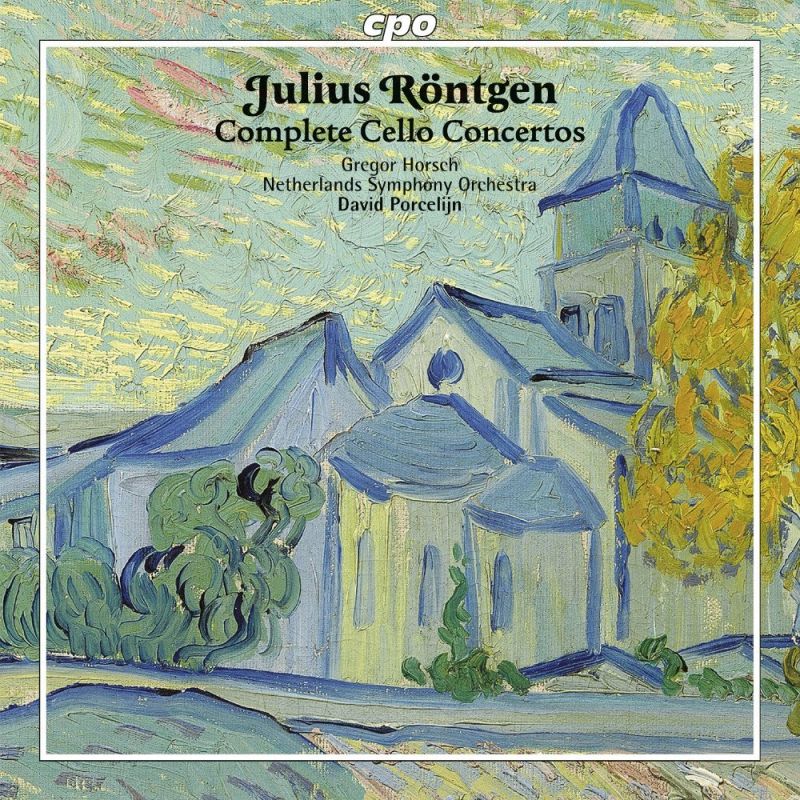RÖNTGEN Cello Concertos
View record and artist detailsRecord and Artist Details
Composer or Director: Julius Röntgen
Genre:
Orchestral
Label: CPO
Magazine Review Date: 02/2014
Media Format: CD or Download
Media Runtime: 62
Mastering:
DDD
Catalogue Number: CPO777 234-2

Tracks:
| Composition | Artist Credit |
|---|---|
| Concerto for Cello and Orchestra No 1 |
Julius Röntgen, Composer
David Porcelijn, Conductor Gregor Horsch, Cello Julius Röntgen, Composer Netherlands Symphony Orchestra |
| Concerto for Cello and Orchestra No 2 |
Julius Röntgen, Composer
David Porcelijn, Conductor Gregor Horsch, Cello Julius Röntgen, Composer Netherlands Symphony Orchestra |
| Concerto for Cello and Orchestra No 3 |
Julius Röntgen, Composer
David Porcelijn, Conductor Gregor Horsch, Cello Julius Röntgen, Composer Netherlands Symphony Orchestra |
Author: David Fanning
Like so many academic late-Romantics, Röntgen is strong on control but not so much on flights of fancy. Occasional phrases do promise wondrous things but he cannot stay in that zone for more than a few seconds at a time. You can tick off the influences and affinities as they pass – Schumann, Brahms, Grieg, Borodin and Tchaikovsky are all there, as is the benchmark of Dvo∑ák’s Concerto. If you think you catch a few bars of the ‘Melancholic’ Temperament from Nielsen’s Second Symphony in the finale of the Third Concerto, that’s probably because the two composers were firm friends for many years, and Röntgen did much behind the scenes to ensure that Nielsen’s music had some kind of profile in Holland.
The Third Concerto (1928) opens the disc, which means that the most attractive music is the first to hit the ear. Its single 15-minute movement has a number of lovely ideas – not least the appearance of a celesta at strategic points – and is never in danger of outstaying its welcome. The opening movement of the First Concerto alone is the same length, however, and really can’t seem to take the hint. Röntgen was brought up and musically formed in Leipzig, and it shows in this safe, well-crafted but largely predictable work, even when the finale tries to blend Paganini’s La campanella with Schumannesque routines. The Second Concerto (1909) is a considerable advance. Partly based on an Irish folksong, it is never less than delightful fodder for cello-buffs but probably no more than that.
Huge credit to Gregor Horsch, David Porcelijn and the Netherlands Symphony Orchestra for doing their utmost to fan the modest flames of Röntgen’s inspiration, and to CPO for their continuing mission to plug the massive gaps in the documentation of the conservative late-Romantic repertoire.
Discover the world's largest classical music catalogue with Presto Music.

Gramophone Digital Club
- Digital Edition
- Digital Archive
- Reviews Database
- Full website access
From £8.75 / month
Subscribe
Gramophone Full Club
- Print Edition
- Digital Edition
- Digital Archive
- Reviews Database
- Full website access
From £11.00 / month
Subscribe
If you are a library, university or other organisation that would be interested in an institutional subscription to Gramophone please click here for further information.




